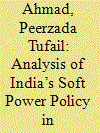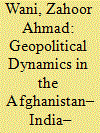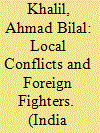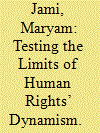|
|
|
Sort Order |
|
|
|
Items / Page
|
|
|
|
|
|
|
| Srl | Item |
| 1 |
ID:
188814


|
|
|
|
|
| Summary/Abstract |
Since 2001, India has pursued a non-military, non-coercive and co-optive (soft power) policy towards Afghanistan. India’s soft power approach of forging economic (aid), humanitarian, capacity building and institutional links vis-à-vis Afghanistan tried to win the hearts and minds of the Afghan government (pre-August 2021) and the ordinary Afghans. The data reveal that India has impacted and generated goodwill by spending billions of dollars on infrastructure. The method used in this study is primarily analytical and explanatory. The research for this study is based on both primary and secondary sources, collected from both archival and online resources. The focus of this article is to comprehensively study and evaluate the usefulness of India’s soft power policy in Afghanistan since 2001.
|
|
|
|
|
|
|
|
|
|
|
|
|
|
|
|
| 2 |
ID:
188811


|
|
|
|
|
| Summary/Abstract |
This article explores the similarities between Afghanistan’s Emirate II and Emirate I in terms of foreign relations. It argues that since 15 August 2021, when the Taliban took over the government in Afghanistan and established Emirate II, there have not been significant changes in their foreign relations behaviour in comparison to Emirate I, which ruled Afghanistan from 1996 to 2001. To prove this claim, the article first examines the objectives of foreign relations of both the regimes comparatively. Subsequently, the foreign behaviour of the two regimes concerning neighbours including Pakistan and Iran will be examined. Finally, the foreign relations of Emirates I and II towards great powers like the USA and Russia are explored in detail.
|
|
|
|
|
|
|
|
|
|
|
|
|
|
|
|
| 3 |
ID:
188813


|
|
|
|
|
| Summary/Abstract |
Since the partition of the subcontinent in 1947, the geopolitics of South Asia has been shaped by a dynamic triangular relationship among Afghanistan, India and Pakistan on which depend prospects of peace, governance and stability in the South Asian region. This article examines how and why the Afghanistan–India–Pakistan triangle emerged and how it affects the entire South Asian region as a matter of geopolitics. The article also analyses why major strategic and political shifts occurred in these complex relations after the fall of the Taliban rule in Afghanistan in 2001 and ventures to provide some comments on more recent developments. The evolution and nature of the triangular engagements lie in the overlapping policies of these three countries. Hence, I identify their interactions as constituting a dynamic triangle. This article argues that strategic positioning and concerns and claims for political space have shaped their relationship to such an extent that if something bad happens in one of the three countries, this affects the position of the other two as well. That is why the current re-alignments in Afghanistan have crucial implications for the whole region, not just in terms of their respective foreign policy objectives but also for the long-term harmony, peace, progress and stability in the whole region.
|
|
|
|
|
|
|
|
|
|
|
|
|
|
|
|
| 4 |
ID:
188810


|
|
|
|
|
| Summary/Abstract |
The emergence of the Afghan Arabs phenomena is the by-product of the Afghan ‘jihad’. The Arabs that mostly came to Afghanistan sought to fulfil a ‘religious’ duty in the form of jihad. This migration process from the Arab countries to the Af-Pak region was in line with the USA, Pakistan, Afghan mujahideen, Arab countries’ policies and volunteering fighters’ personal beliefs.
The Afghan Arabs were not a homogeneous group; they were ideologically and strategically fragmented and had different groups and views. Hence, all Afghan Arabs did not end up in Al-Qaeda. Despite this fragmentation, Afghan Arabs played an essential role in the Afghan conflict, from raising funds to providing volunteer fighters and coverage of ‘jihad’ through their media sources. They also intervened in the affairs of Afghan mujahideen groups. They either sided with the opposing jihadi factions (and later with the Taliban) during the Afghan Civil War or remained silent. In the post-2001 period, their role was limited to technical support and fighting against the ‘common enemy’. In this period, the Taliban’s policy towards Al-Qaeda was to not condemn, not cut ties, to regularise them while officially rejecting their presence.
|
|
|
|
|
|
|
|
|
|
|
|
|
|
|
|
| 5 |
ID:
188815


|
|
|
|
|
| Summary/Abstract |
The Taliban takeover of Afghanistan in August 2021 caused a humanitarian catastrophe in the country that triggered en masse exodus of a new wave of Afghan refugees desperate to flee the clutches of the Taliban. Although Pakistan and Iran had traditionally been the two main destinations of refuge for Afghans, yet for some Afghans—especially for the non-Muslim minority communities of Afghanistan, namely the Afghan Hindus and Sikhs—India has always been the foremost destination for refuge. The article aims to understand the experiences of the mentioned communities, as they moved from pre-conflict, to conflict, displacement and finally to the settlement phase in India. Thus, the article throws light on the experiences of Afghan Hindus and Sikhs both in their home and host countries and, in the process, engages with various aspects of the negotiations and marginalisation endured by them. It then strives to explore their sense of belonging at the scales of state, individual and community by discussing the significance and impact of the Citizenship (Amendment) Act, 2019, specifically for the members of Afghan Hindu and Sikh diaspora in India. A plethora of research has been produced that focuses on various aspects of India’s relation with Afghanistan, but the issues of the Afghan religious minorities in India remained a neglected topic of scholarly research. This article attempts to remedy this lack of literature by examining the unexplored dimension of India’s engagement and support for Afghan Sikhs and Hindus.
|
|
|
|
|
|
|
|
|
|
|
|
|
|
|
|
| 6 |
ID:
188809


|
|
|
|
|
| Summary/Abstract |
Today, Afghanistan finds itself in the cross hairs of a security vacuum and a near-failed state, where the increasing radicalisation of its populace appears to be an inevitable reality. Despite the overthrow of the Taliban in 2001 by the allied forces, it was able to resurge as a powerful non-state actor from 2006 onwards, under the leadership of Mullah Omar. However, that failed to prevent the emergence of other terrorist groups, like the Islamic State—Khorasan Province (ISKP), whose formation in 2015 heralded the beginning of the ongoing rivalry between the two organisations. Even though tracing their origin to terrorist outfits such as the Afghan Taliban and Tehreek-i-Taliban Pakistan (TTP), ISKP terrorists who formed the Khorasan branch of Islamic State (ISIS) consider the Hanafi-based organisations not ‘extremist enough’. Furthermore, the ISKP leaders denigrate the Taliban for their ethno-nationalist ambitions that fail to align with its pan-Islamic and extremist version of Salafist Islam. The ideological conflict, reinforced by resource-based competition and dynamics introduced by other jihadist groups such as the East Turkestan Islamic Movement (ETIM) and TTP, and the state actors like Pakistan, will continue to worsen the geostrategic and humanitarian crises unfolding in the country, with broad regional implications.
|
|
|
|
|
|
|
|
|
|
|
|
|
|
|
|
| 7 |
ID:
188812


|
|
|
|
|
| Summary/Abstract |
While the Universal Declaration of Human Rights (UDHR) deems human rights as universal and uniformly applicable to all societies, John Rawls’s idea of rights offers a narrower account of human rights which would be differential and acceptable to different societies and people. The notion emphasises that human rights move on a spectrum of continual development with regard to particularities and changing needs of different societies. Such an approach to human rights, Rawls argues, leads to better implementation of international human rights. Rawls’s analysis of human rights’ dynamic nature, however, remains confined only to macro-level variation of human rights among different societies. This article argues that human rights also vary within the same society. It charts how Afghan women’s conception of human rights has evolved from one period of the Taliban rule to another. This evolution indicates how, with the passage of time and the effect of external factors, new variants of women’s rights have emerged and became fundamental to the Afghan society. The article suggests that the Islamic Emirate of Afghanistan (IEA) should not ignore this evolution and development. Rather, it can seize the opportunity to cooperate with the international community and foreign powers to implement women’s rights within a middle framework between human rights notions of Rawls and the UDHR.
|
|
|
|
|
|
|
|
|
|
|
|
|
|
|
|
|
|
|
|
|